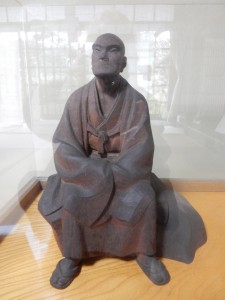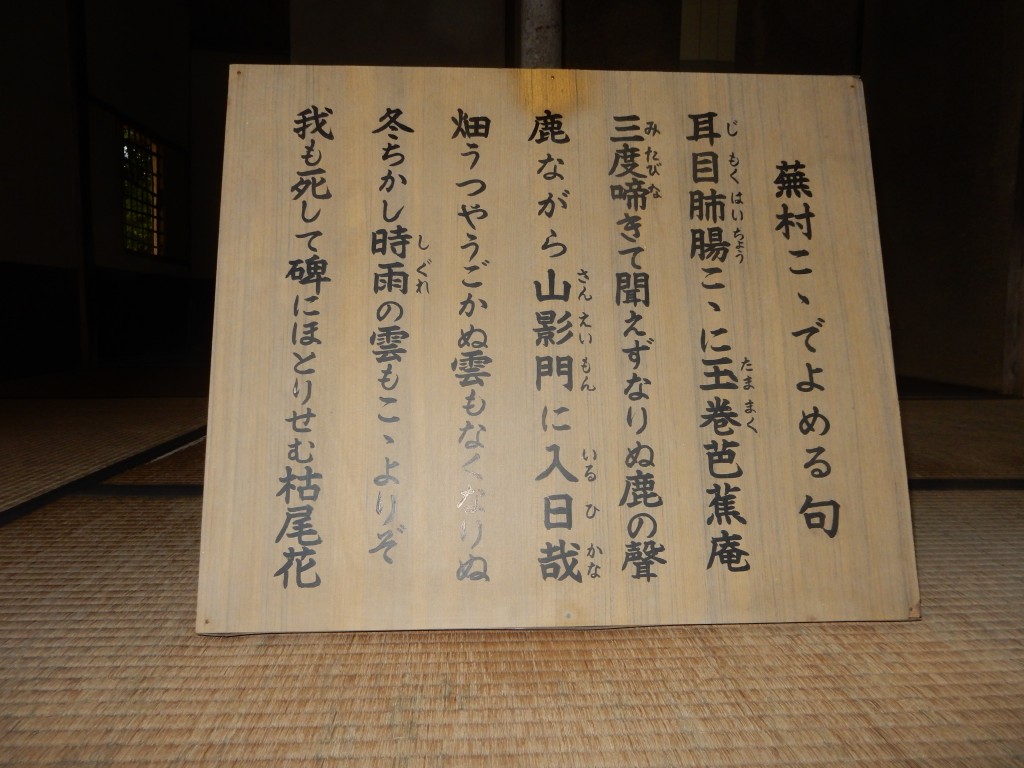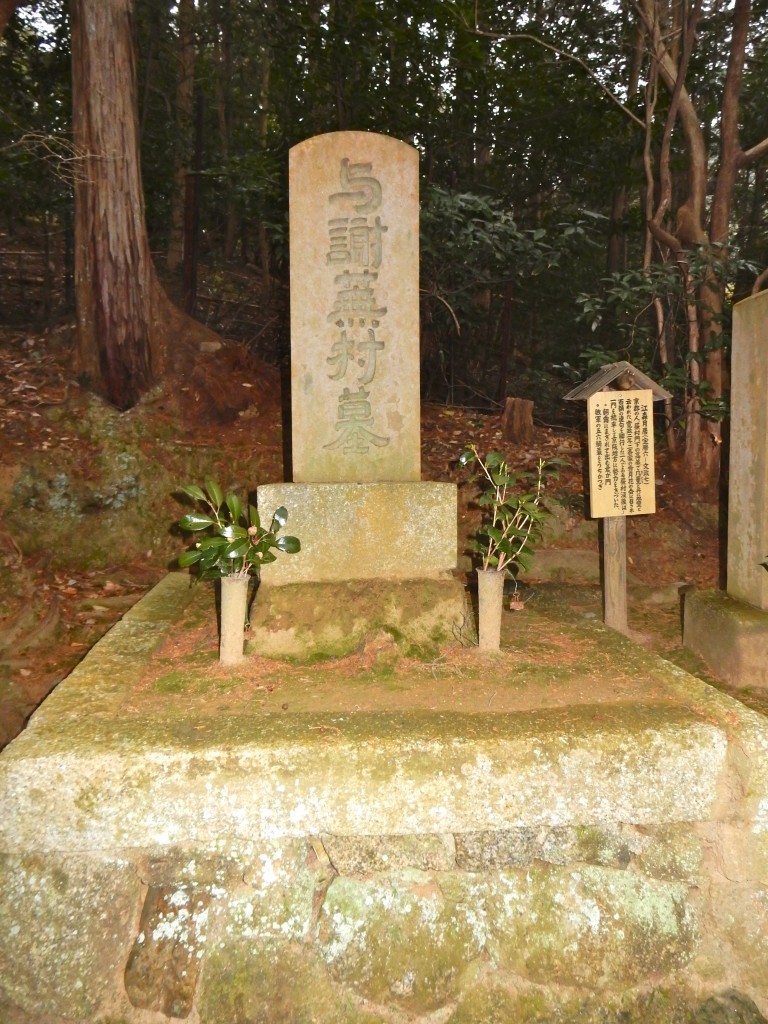
Basho-an, the hut at Konpuku-ji that Buson (re-)built in honour of his predecessor who stayed at the temple
The well-known haiku poet Yosa Buson (1716-84) ranks among the finest of Kyoto’s literary figures. Born in what is now Osaka, he moved to Edo and studied poetry. After years of moving around, including following the footsteps of Basho to The Deep North, he settled in Kyoto at the age of 42 and took the name of Yosa (after his mother’s birthplace in Tango). He married at 45, had a daughter and made a career as a successful painter as well as teaching poetry. In 1776 he tracked down the Basho-an where the poet had briefly stayed nearly a hundred years earlier, and rebuilt it as a teahouse where he held poetry gatherings. It stands still on an incline at the back of Konpuku-ji, a Zen temple in north-east Kyoto (near Shisendo). Near it is a well said to have been used by Basho and a stone monument that Buson erected bearing poems by his predecessor. The artist-poet wrote a haibun about the restoration (translated in Yuki Sawa and Edith Shiffert Haiku Master Buson), and he was so enamoured of the place that he wrote:
When dead let me lie
Near the Basho monument –
Withered pampas grass
Buson’s grave lies just above the Basho-an, surrounded by the graves of several of his followers. With its panorama and natural surrounds, it provides a fitting setting for reflection on the nature of haiku and Buson’s poetry in particular. Ars longa vita brevis.
“He always loved Kyoto’s beautiful landscapes and never forgot to view cherry blossoms and the red maple leaves of the eastern suburbs and western mountains.” (taken from Yuki Sawa and Edith Shiffert’s Haiku Master Buson Heian International, 1978)
Ganjitsu futsuka kyo no sumizumi kasumikeri
New Year’s Day
and on the day after,
fog from place to place in Kyoto. (tr. Sawa and Shiffert in Haiku Master Buson)

Statue of Buson exhibited at Konpuku-ji
At Basho-an
Fuyu chikashi shigure no kumo mo koko yori zo
Almost winter,
and the cloudiness of a shower
where it begins from (tr. Sawa and Shiffert)
hana ni kurenu waga sumu kyo ni kaen’nan
Darkness on the blossoms –
back to Kyoto where I live
now I will return (tr Sawa and Shiffert)
(Daimonji ya tanima no tsutsuji moen tosu)
Daimonji –
Azaleas in the dale
Just about to blaze
Amid white plum blossom
night turns to dawn –
the time has come.
(written when dying)
黄昏や萩にいたちの高台寺
Kodaiji temple;
A weasel in the bush clover
at dusk. (Tr. Blyth)
kyou no mizu no ai yori idete kakitsubata
From Kyoto’s
Indigo water born –
Irises in bloom
nawashiro ya Kurama no sakura chirinikeri
Beds of young rice plants –
Mt Kurama’s cherry blossoms
have all fallen off
(tr. Sawa and Shiffert)
hottotogisu Heianjo o sujikaini
Hototogisu
over the Heian castle town
flying aslant.
(tr Sawa and Shiffert)
水仙や寒き都のここかしこ (1777)
suisenya samuki miyako no kokokashiko
Daffodils –
In the capital cold
Here and there
(tr. Saito and Nelson)
水鳥や提灯遠き西の京 (1769)
mizudori ya chouchin tooki nishi no kyou
Waterfowl –
Lanterns, distant
Westerly Kyoto
(tr. Saito and Nelson)
The selection that follows is courtesy of Gabi Greve from her Buson page … (tr. Greve unless otherwise stated)
すゞしさや都を竪にながれ川 (1768)
suzushisa ya miyako o tatsu ni nagaregawa
splitting Kyoto
with its coolness –
the Kamo River (tr Dougill and Higashinaka)

Six haiku written by Buson at the Basho-an
遅き日や谺聞ゆる京の隅
osoki hi ya kodama kikoyuru kyoo no sumi
The slow day;
Echoes heard
In a corner of Kyoto.
みじか夜や暁早き京はづれ
mijika yo ya akatsuki hayaki Kyoo hazure
on these short nights
up early at dawn
in Kyoto’s outskirts
(tr Dougill and Higashinaka)
shira-ume ya Kitano no chaya ni sumahi-tori
The white blossoming plum
at the Kitano tea shop
a sumo wrestler
haru no mizu ni utata u nawa no keiko kana
How serious the training
of cormorants with ropes
on the water in Spring!
tenzoo no niwa no kogiku ya ginkakuji (1777)
the small chrysanthemum flowers
in the garden of the temple cook –
Silver Pavillion

Buson, R.I.P. The grave at Konpuku-ji is set at the edge of woods overlooking the city in a site conducive to poetry.
A fire festival –
Beautiful in the frost
In Kyoto city. (tr. Saito and Nelson)
ohitakiya shimo utusukushiki kyou no machi (1769)
御火たきや霜うつくしき京の町
としひとつ積るや雪の小町寺
toshi hitotsu tsumoru ya yuki no komachidera (1773)
Another year
Accumulates — Snow at
Komachi Temple. (Tr. Nelson/Saito)
Gabi Greve notes: Fudara-Ji 補陀洛寺(小町寺 Komachidera )
. Ono no Komachi 小野 小町 .
c. 825 — c. 900. Waka Poetess and Famous Beauty
The following from Gabi Greve’s Edopedia site, concern kaomise (showing the new faces at Kabuki), though whether it’s the Kyoto kaomise I can’t be certain as there was also kaomise for kabuki groups in Edo. When Buson was young, he spent time in Edo. However, the dates given below are from the period after he’d made Kyoto his home. Moreover, the mention of Higashiyama is clearly indicative of Kyoto…
kaomise no maku ni yahan no arashi kana
Against the theatre curtains
At the season’s start
Blows the midnight tempest. (Tr. Nelson/Saito)
*******
顔見世やふとんをまくる東山
kaomise ya futon o makuru Higashiyama
********
顔見世や夜着をはなるる妹が許
kaomise ya yogi o hanaruru imo ga gari
********
kaomise ya sude ni ukiyo no meshi jibun
(1776)
A theatrical season, its first day enjoyed–
Already in this world of sadness
Time to eat (Tr. Nelson/Saito)
********
tabidachi ya kaomise no himo miyuru naru
(1768)
Leaving on a journey–
Lights are seen
The theatrical season begins. (Tr. Nelson/Sait)






Recent Comments